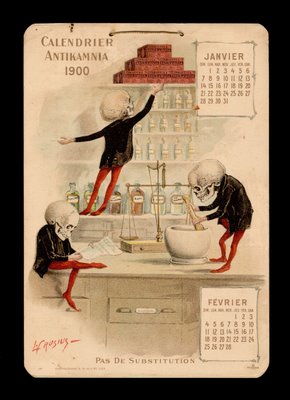
Illustrations for Antikamnia Chemical Company Calendars, 1900 & 1897
Louis Crucius, ~1890
BibliOdyssey turned up this wicked advertising campaign by turn-of-the-century pharmaglomerate Antikamnia Chemical Company. The calenders were targeted at medical professionals, not the average consumer, for whom I presume a baby skeleton in a christening gown would be a slight turn-off.
I like the little pharmoompa-loompas the best. I wish I’d had some in grad school. Or for grading exams. . .
By the way, this is exactly why illustrators need skulls as references. Crucius must have had access to a newborn’s skull as well: note the broad, thin mandible and the diamond-shaped fontanel (soft spot) on top of the head. It’s a fairly accurate drawing.

Just amazing ! I love these old-style drawings. Their “memento mori” component (“Impermanence”, as a bouddhist would call it) is probably more shocking to the general public now than it was at the time (even within the medical community). With the high rates of child death, and 1/3rd of women losing life while giving birth in the late XIXth, possibly the relationship to death of these people was very different from ours. Our absurd concealment of death to the edge of society (closed hospitals and graveyards out of the city) has made the very concept extremely abstract in our minds, while it was surely more of an obvious and accepted reality to the people of the XIXth century. Today, a mother whose child dies is seen as a victim of a terrible and unjust fate. But as late as pre-WWI, EVERY mother or almost had been in that situation at some point. I think it sheds an interesting perspective on the way we react now to such drawings.
Although I can’t say that *I* would like to hang that calendar on my wall, I don’t feel all that disconnected from death– in fact, as a mother, I think about it WAY more than I used to. But then, I have two graveyards within easy walking distance of my house. When I pushed my stroller past an open grave on Tuesday, the particularly fresh juxtaposition of life and death was not lost on me.
I think that’s a very heatlhy attitude of yours, mdvlist (if I may use the word “healthy” in this unexpected context). It reminds me of a striking (but intrinsically beautiful) view in Kyoto, where 1600 temples are spread throughout the city, generally associated with a small graveyard. With so many graveyards all around the place, you sort of “bump” into them in any of your stroll around the city. And the view in question, which stroke me, was that of a graveyard located right in the middle of a shopping mall, in the south of Kyoto (near the railway station, for those who have been there). The mall was built long after the founding of the temple and of its graveyard, and of course shops were built around it. So you see young japanese ladies or entire families doing their usual saturday shopping in the mall, with hands full of bags ripe with food, fancy accessories, stylish dresses or brand-new shoes, and they stop right in the middle of the mall, lay their shopping bags on the floor, remove their shoes and stop shopping for five minutes just to share a little prayer for their dead relatives there. And right way, they grab their bags again and dive back into their shopping frenzy. I ADMIRED this. Nothing gruesome in there, and nothing disrespectful for the dead either: they were just there, buried right where people live their every-day life, as they should. Not concealed and hidden away. It was a real eye-opener to me.
Go to Kyoto on day if you can: it will change your perspective on many accounts, I am sure.
Be well,
Pierre
At the risk of sounding trite, I like graveyards. When I bought my last house, I hoped I could get one opposite the graveyard. I find it comforting that people are able to achieve a closeness and reverence for their lost loved ones though a physical pilgrimage to a place. I felt similarly watching footage of the crowds in London after the death of Princess Diana: they needed on a very basic level to have a place to go to show their grief. It was somehow reassuring.
It is true that the death of a child was a much less shocking event in previous centuries. But I’m still unconvinced the baby skeleton would have been the sort of calendar a non-professional would use. . . just because infant death was common didn’t mean it was prosaic, and these illustrations are clearly meant to be amusing, not stoic or reflective of God’s will.
I was just in Kyoto two Christmases ago, but I missed out on the cemetery in the mall! I suppose that’s what happens in a country where space is at a premium. I’ve actually been to a cremation in Japan (not to brag, or anything . . .)– talk about closeness to the dead. The family are all supposed to gather round afterwards and handle the remaining bones in the box of ashes. (Mind you, I don’t know how they do cremations in the states, so maybe that’s not so particular to Japan?)